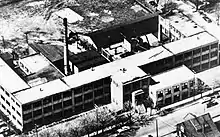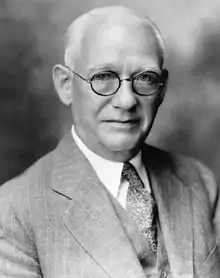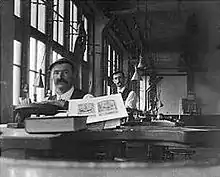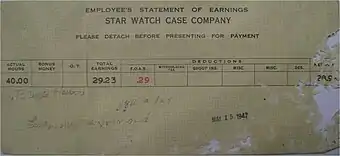Star Watch Case Company
The Star Watch Case Company was a company in Ludington, Michigan, that operated from approximately 1905 to 1982. It designed and manufactured watch cases. The company would receive the internal watch mechanism from other factories and did the final assembly. The final product was made ready for the customer and then could be sold. Pocket watches were first made and later wristwatches were made. The company was involved in making small mechanical parts for military equipment during World War II.
 Star Watch Case Company, circa 1980 | |
| Industry | watch cases |
|---|---|
| Fate | dissolved |
| Founded | 1905 |
| Defunct | 1982 |
| Headquarters | Ludington, Michigan |
Key people | Otto "Bub" A. Starke, Fritz A. Baumgartner |
| Products | watch cases |
Number of employees | 150 start, 550 at peak |
| Parent | Illinois Watchcase Company |


Star's key hand engraver
Product
The Star Watch Case Company manufactured watch cases. Watch movements (the mechanical mechanism), the dial, hands, glass that covers the face of the watch (sometimes called the crystal), and some of the crowns (the button used to wind the watch) were made in another location and shipped to Star to assemble the final watch product. Some of the companies it made watch cases for were Manistee Watch Company, Hamilton, Longines, Elgin, Gruen, Omega and Pulsar.[1]
Pocket watch cases were the only product made to World War I.[2] They were solid gold or gold filled, sterling silver, rolled nickel-silver and brass.[3] They included open face style and hunting style cases.[2] After this time wristwatch cases were additionally produced. The company also manufactured certain military items during World War II.[4]
Early history
The company started in 1897 making watch cases as an Illinois watch company in Elgin, Illinois. The founders were Otto A. Starke, Fred Hermann and Alfred W. Church.[5] Sometime around 1902 to 1903 there was a large fire that destroyed the factory. The materials were well insured, so the factory was able to recover from this. At the time the factory had 27 employees and was a bustling business. The Illinois watchcase company changed its name sometime between 1903 and 1905 to the Star Watch Case Company.[6] The company incorporated on February 7, 1905. The first officers of the new Star Watch Case Company were Otto A. Starke as its president; Fred Hermann, vice president; Warren Antoine Cartier, secretary; and Alfred W. Church as the treasurer.[7]
Star Watch Case Company moved in 1905 to Ludington, Michigan. The initial factory building was built on south Rath Avenue and had expanded by 1910.[8] By 1913 it had about 150 employees. There was a north and south wing added to the main building in 1920. The company employed 400 men and women in 1925.[9] Another expansion wing for tool and die equipment and machinery was added in 1927. An addition for a new company office was made in 1943.[8] The company was Ludington's largest employer and had a peak employment of about 550 employees at its height, which was in the middle of World War II. The building for the company was three stories for offices and manufacturing. Over time it expanded to over 70,000 square feet.[5] The company is sometimes referred to as the Star Watchcase Company.[10]
Engravers
Fritz A. Baumgartner was the company's key hand engraver from 1906 in the Ludington factory. Other hand engravers were Emil Allemann and Otto Starke.[6]
Factory

 Star Watch factory, c. 1905
Star Watch factory, c. 1905 Star Watch factory, c. 1920
Star Watch factory, c. 1920 1919-1924 Star Watch logo
1919-1924 Star Watch logo Star Watch polishing tanks
Star Watch polishing tanks
 Employees circa 1919
Employees circa 1919 Case fitters, circa 1919
Case fitters, circa 1919 Fitting room, circa 1920
Fitting room, circa 1920 Engineering Department
Engineering Department
Military
Pocket watch cases were 90% of Star's production up to 1938. Upon the entry of the United States in the Second World War the factory was converted to making brass compass cases, small weapons, and submarine parts. The company had a reputation for making quality military stainless steel military watch cases and cases for military compasses.[5] During World War II the company also manufactured components of military navigational aides. One such military component was the top secret Norden bombsight, used for dropping bombs accurately from airplanes in World War II.[11]
NASA
Star Watch Case Company made watch cases for the model Omega Speedmaster Professional, one of which was worn by astronaut Eugene A. Cernan on a trip to the moon.[12] This watch is commonly referred to as the "Moonwatch."[13][14] Other like models of Star's were worn on various space missions.[13][14]
Pantograph machine
Andrew Hallberg invented a pantograph machine that allowed up to 32 watch backs to be engraved at the same time. Star watch Case Company was the patent owner of this invention since Mr. Hallberg was an employee of the company. The cutting-edge technology was kept secret so competitors would not learn of this mass-production method. This gave the company an advantage in fast watch case production.[5]
These etching machines are at the White Pine Village museum.
 Engraving machine
Engraving machine Master Design Plate
Master Design Plate
The tool and die engineer would place the watch cases in a fixture that would hold them in place. A Master Plate design was then selected for the design desired. The pantograph machine would then reduce the design and accurately reproduce it on the backs of the watch cases. The operator would use a lever that followed the Master Plate design and the diamond tipped cutting tools would cut the design into the blank watch cases. The pantograph machine invented by Andrew Hallberg around 1910 led to hand engraving of pocket watches becoming obsolete after 1930.[7]
Case Grades

- "Star" Gold-Filled, guaranteed for 20 years as late as November 1906, 25 years by April 1909
- Defiance Gold-Filled, guaranteed for 10 years
- Majestic Gold-Filled, guaranteed for 5 years
- Stellar, 10K Rolled Gold Plate case
- Scepter, Gold-Filled or Rolled Gold Plate case
- Excellence, Silver case
The raw materials Star Watch Case Company used for watch cases were gold, silver, nickel, brass, zinc and chrome-plated cases; solid gold or gold filled being the most preferred. Their gold supply in bars was held in a local Ludington bank, then as need some bars were transferred to the factory for melting down. The factory always held around $200,000 worth of gold at any one time for watch cases of 10, 14, or 18 karats.[6]
Designs and Trade Marks
An early popular design was of the battleship USS Maine (ACR-1) that had a well known slogan of Remember the Maine, to Hell with Spain!.[5] The company's trade mark is a five-pointed star and also the double-headed eagle.[4] Additional Trade Marks that were used are below:[15]

Demise

The beginning of the end of the company came when Elgin Watch Company decided in the 1950s that a single vendor should not supply more than a third of the company's needs. Star Watch Case Company was dropped off their list of suppliers of watch cases when they obtained another company that made such cases. Two decades later the company was all but out of business. In 1979 it was sold to Société Suisse pour l'Industrie Horlogère and by 1982 it was entirely out of business. All of the company's furnishings and machinery were soon sold. The building was demolished in 1995.[1]
See also
Footnotes
- "Star Watch Case Company". Ludington Daily News. Ludington, Michigan. March 20, 1995. pp. 10–11.
- Niebling, p. 50
- "Use Star Cases". Ludington Daily News. Ludington, Michigan. June 6, 1940. p. 39.
- A History of the American Watchcase by Worren H. Niebling (part 3), Volume 14 Issue 143 p.30 Dec 1969 from the National Association of Watch and Clock Collectors Bulletin
- Leonore P. Williams (June 6, 1940). "Industry on Parade/Star Watch Case Co". Ludington Daily News. Ludington, Michigan. p. 39.
- Linahan, Jack (February 2006). "Star Watch Case Company". National Association of Watch and Clock Collectors bulletin. 51 (360): 29–31.
- Linahan, Jack (February 2000). "Star Watch Case Company". National Association of Watch and Clock Collectors bulletin. 42 (324): 106–108.
- "What industry means to this community". Ludington Daily News-page 4. Ludington, Michigan. September 25, 1963 – via newspapers.com
 .
. - "15 Years Ago". Ludington Daily News. Ludington, Michigan. December 16, 1940. p. 4.
- "White Pine Village tells tale of long ago". Ludington Daily News. Ludington, Michigan. July 19, 1995. p. 24.
- Ludington Daily News, April 16, 1994; p. 1 by Paul Peterson (Managing Editor) During the Second World War, Star Watch Case turned its know-how to the manufacture of components for military navigational aides and even the super secret Norden bombsight, to say nothing of thousands of cases for military compasses.
- OMEGA ambassador Gene Cernan is a star guest at the Knokke Eccentric exhibition
- Lee Bailham and Eric M. Jones (2004). "Apollo Lunar Surface Journal: Omega Speedmaster Professional Chronographs". National Aeronautics and Space Administration. Retrieved 29 June 2010.
- "How the OMEGA Speedmaster became the Moonwatch". Bienne, Switzerland: Omega Watch Company. 6 April 2009. Retrieved 29 June 2010.
- Reference library (2020). "Star Watch Case Co". Pocket Watch Database. Retrieved 16 November 2020.
Sources
| Wikimedia Commons has media related to Star Watch Case Company. |
- Niebling, Warren H., History of the American watch case. Library of Congress Card Number 74-152358, Whitmore Publishing 1971